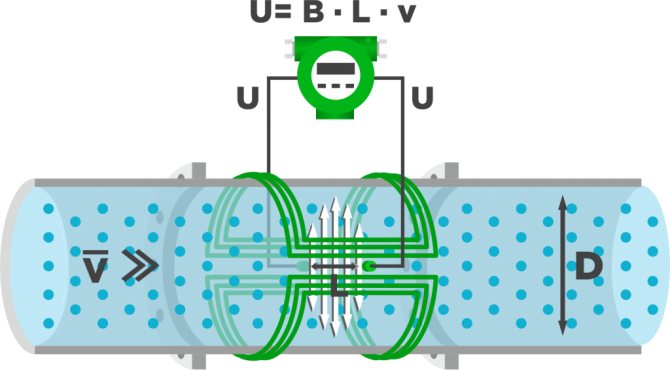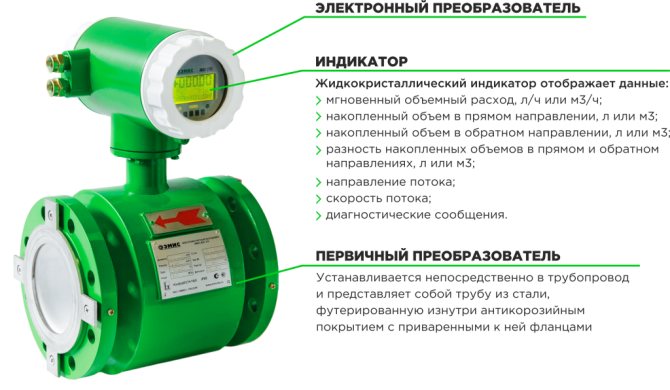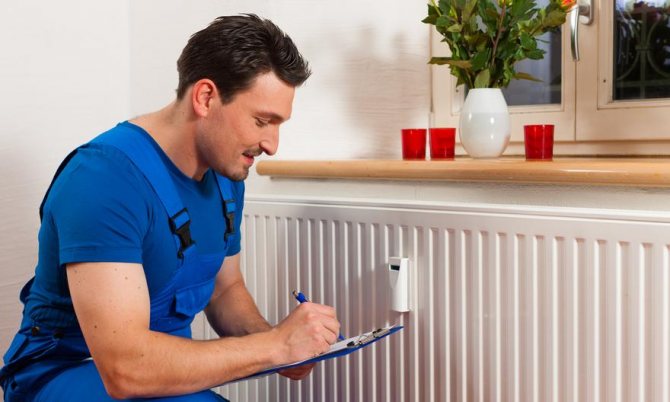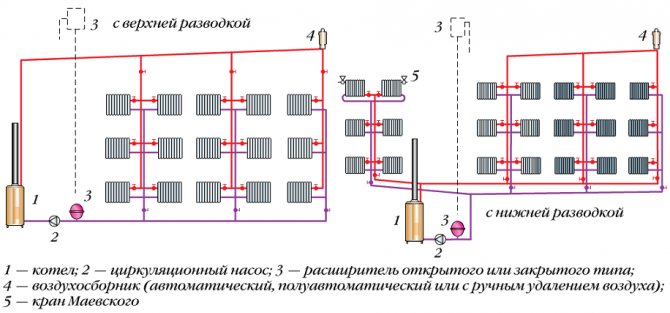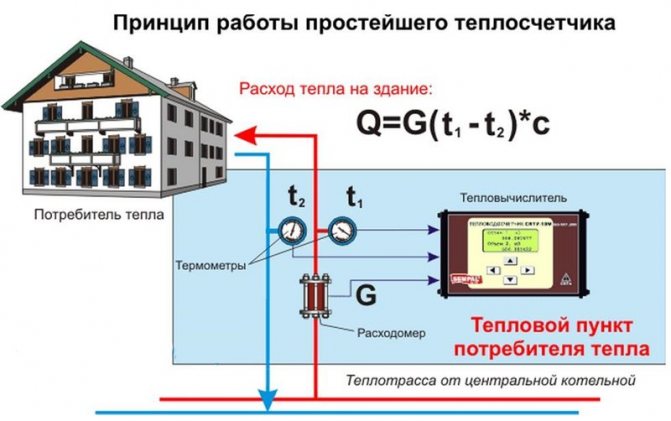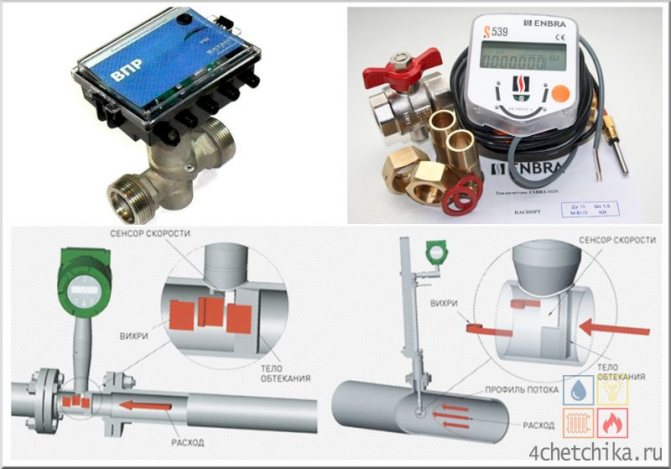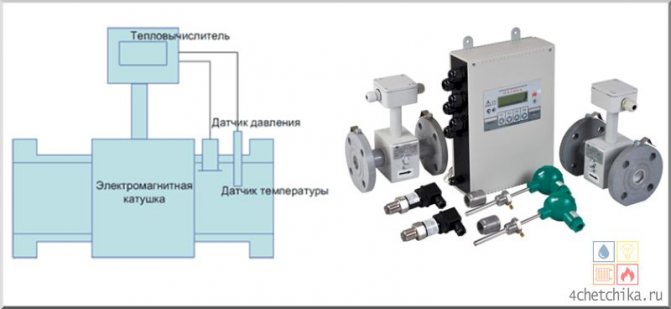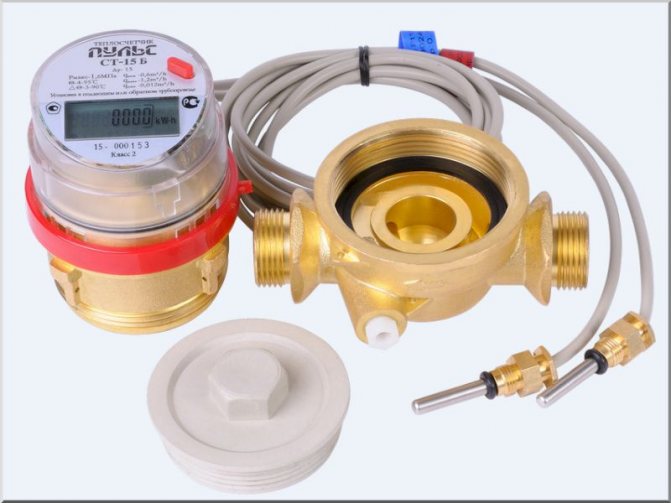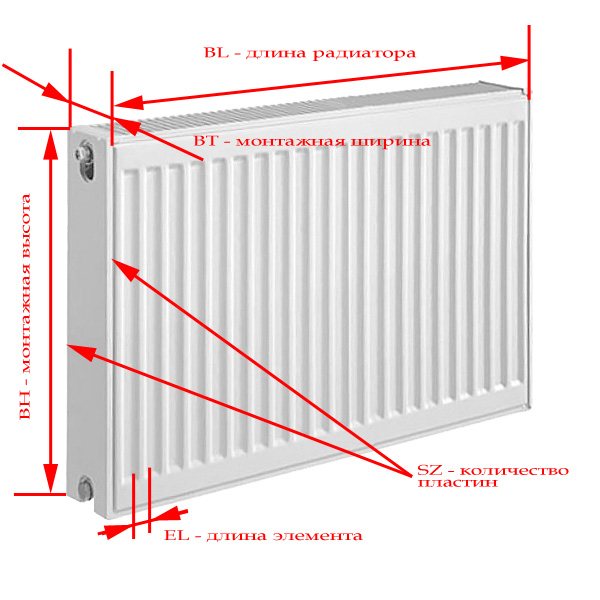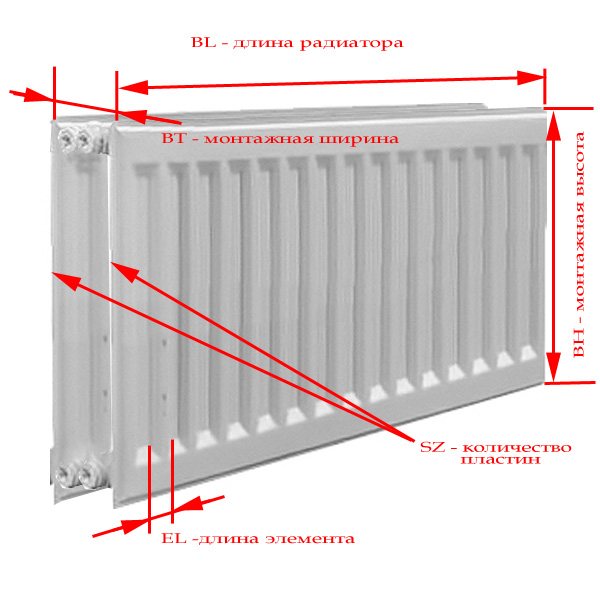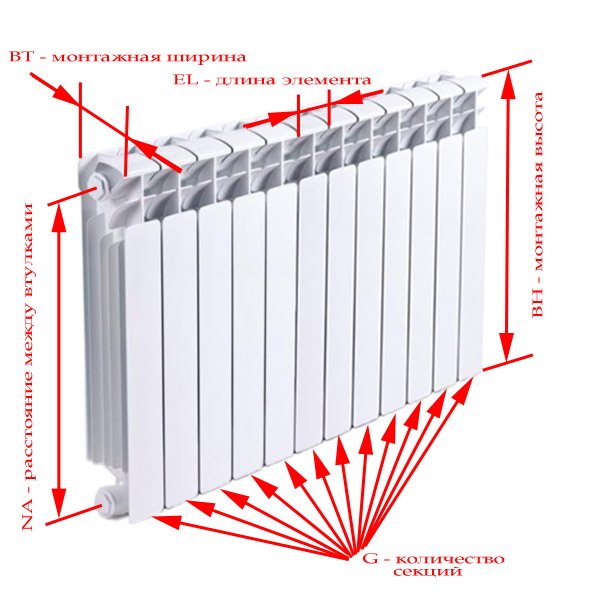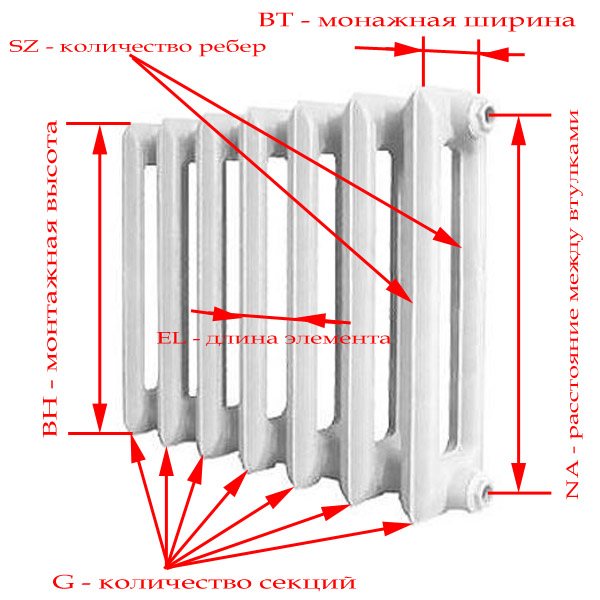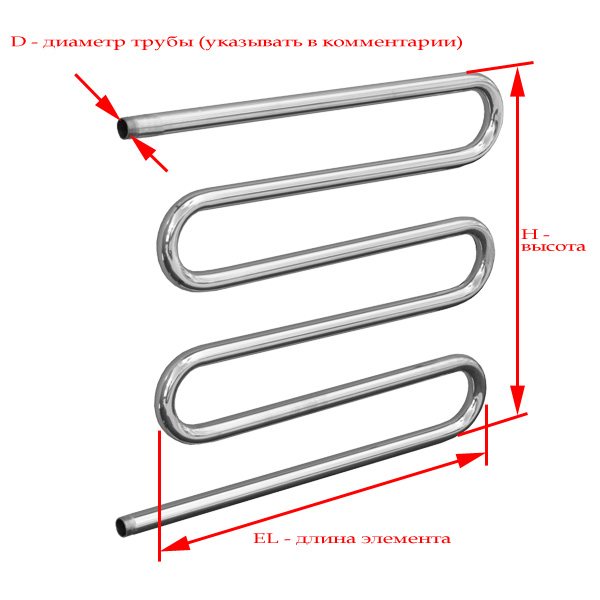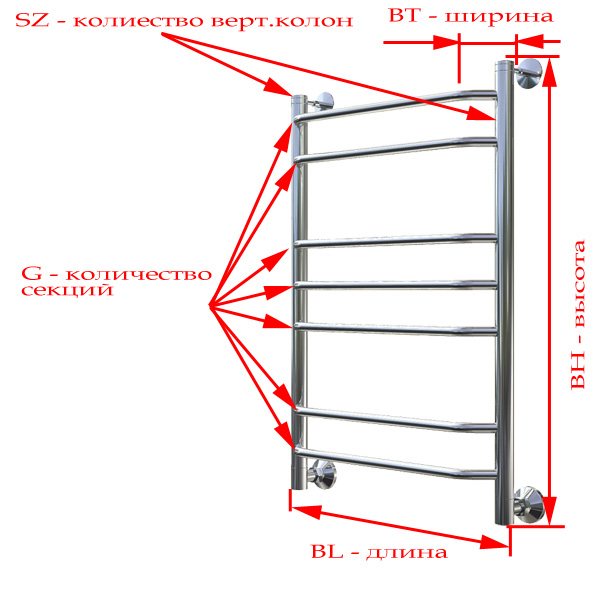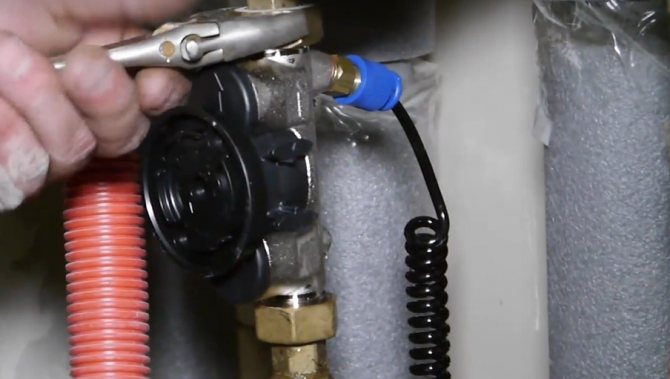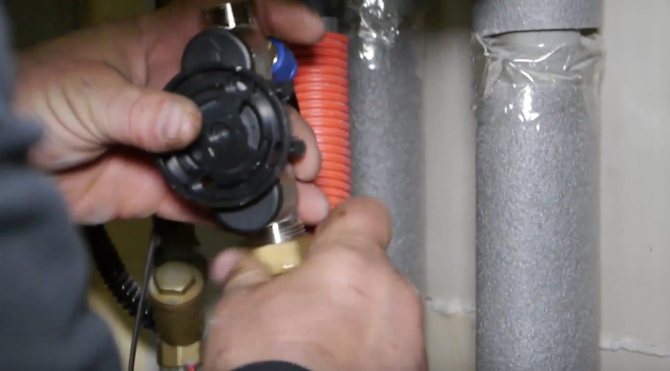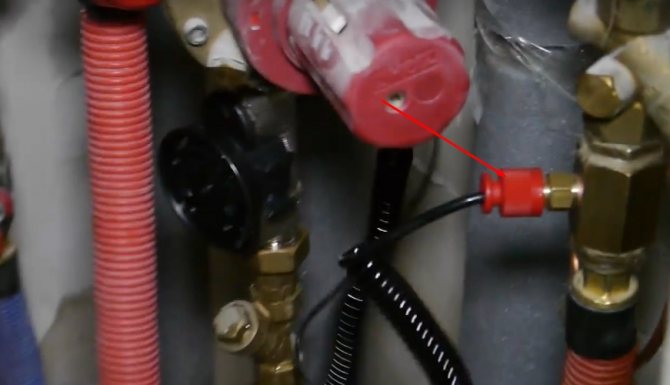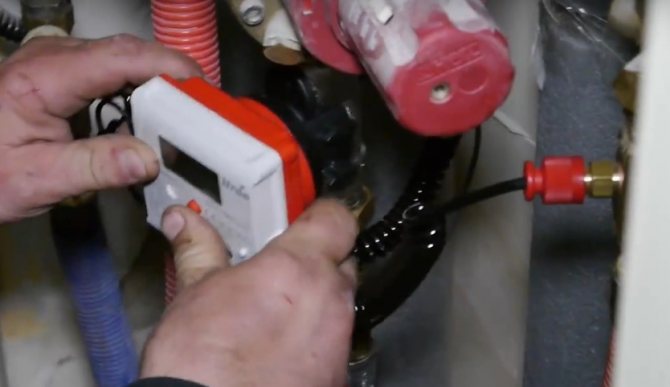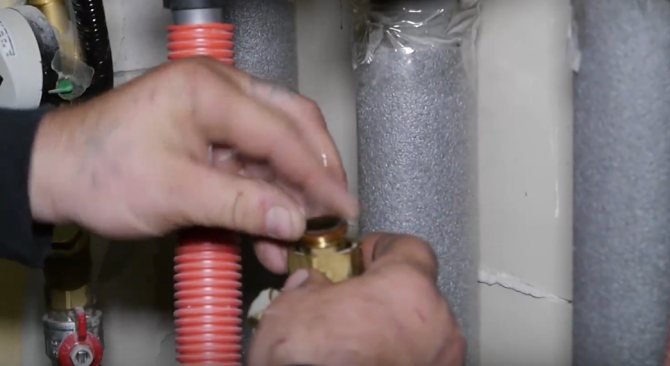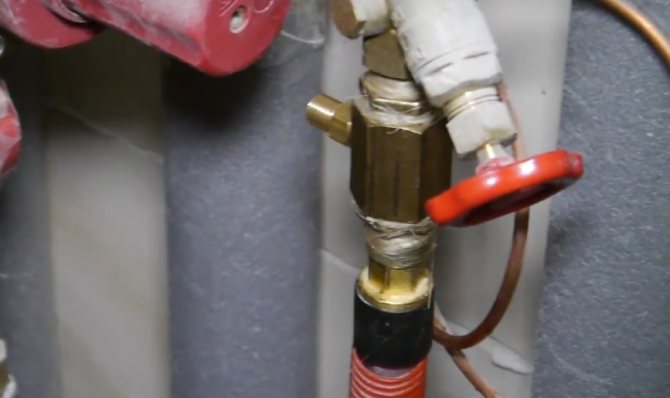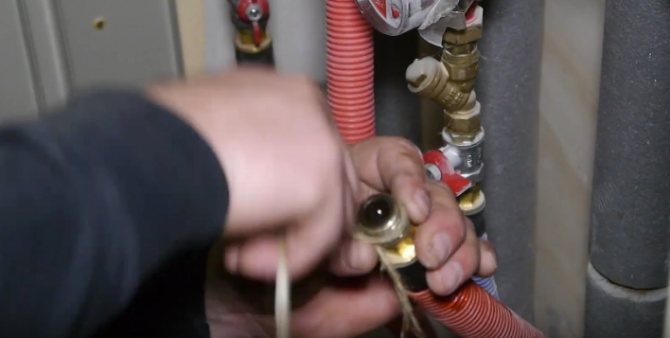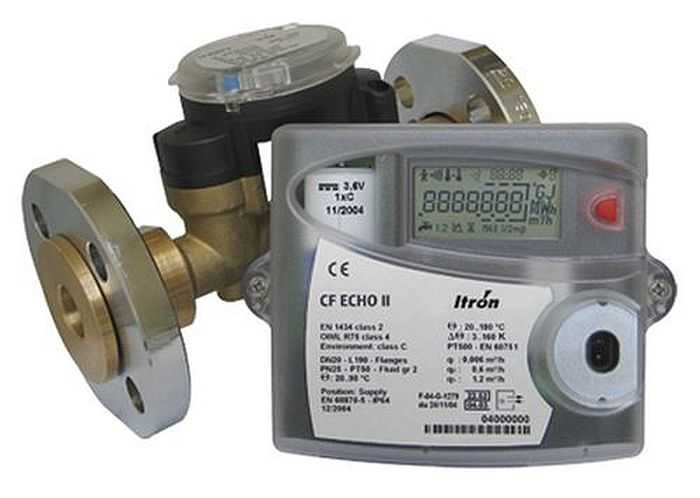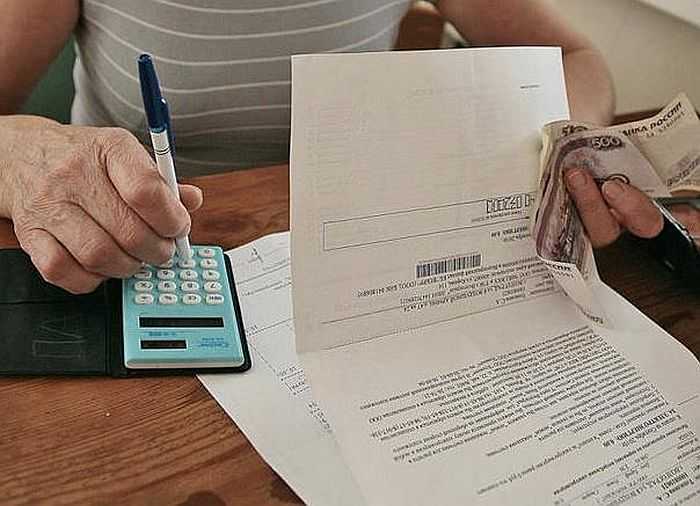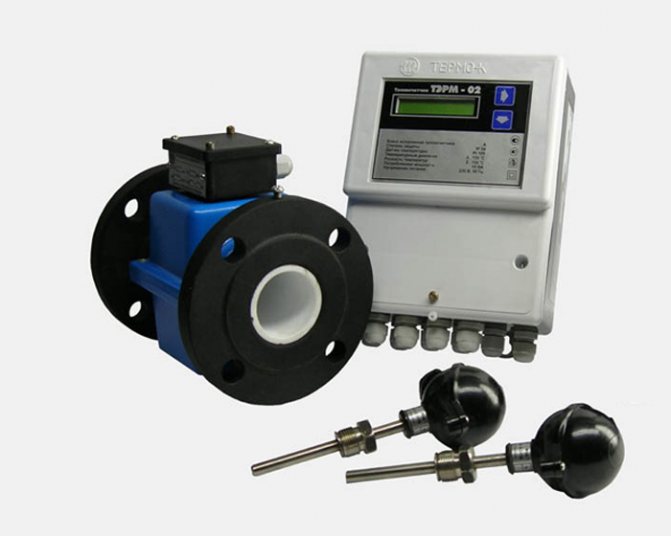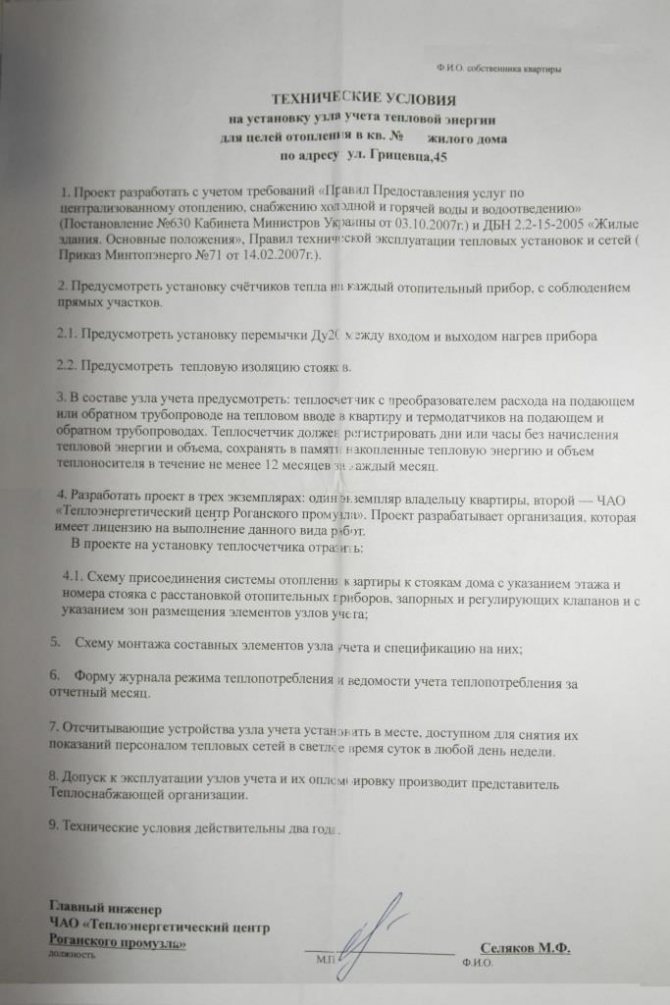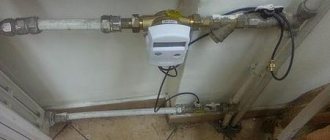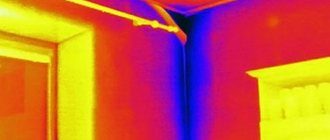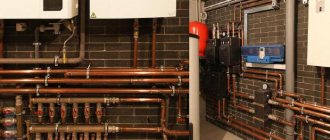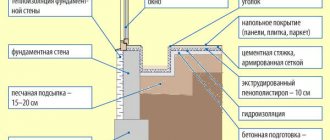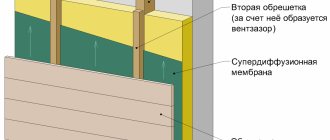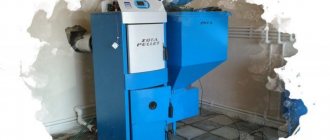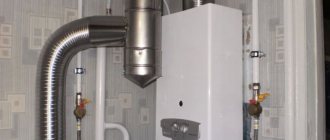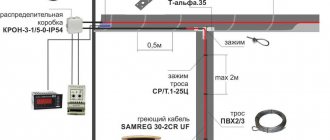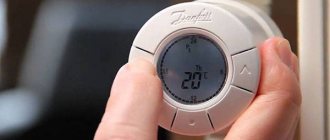Tachometric heat meters
Tachometric heat meters (vane, turbine, screw) are the simplest devices. The principle of operation of mechanical heat meters is based on converting the translational motion of the fluid flow into the rotary motion of the measuring part. Mechanical heat meters consist of a heat meter and mechanical rotary or vane water meters. These are still the cheapest heat meters, but the cost of special filters that are installed in front of each mechanical heat meter must be added to their cost. As a result, the price of such kits is 10-15% lower than other types of heat meters, but only for nominal pipeline diameters not exceeding 32 mm. For pipelines of larger diameter, the price of mechanical and other heat meters is practically equal or even higher.
The disadvantages of mechanical heat meters include the inability to use them with increased water hardness, the presence of small particles of scale, rust and scale in it, which clog filters and mechanical flow meters. For these reasons, in almost all of Russia, the installation of mechanical flow meters is allowed only in apartments, small private houses, etc. In addition, mechanical flow meters generate the highest water pressure losses compared to other types of flow meters.
Connection of heat meters
If your facility has little free space, then we recommend using interflanged (m) flow meters. Their overall length is shorter than the flanged ones, they are lighter and cheaper. If you need flowmeters with a minimum weight and price, we recommend using the threaded version (p). There are no flanges at all, this is ideal for connecting to non-metallic pipelines. Threaded flowmeters are subdivided into two categories according to temperature conditions: standard (up to 150 ° С) and for cold water supply (up to 90 ° С). The latest flow meters are the cheapest.
Electromagnetic heating meter
This is an expensive model of heating devices, and belongs to the most accurate devices. The principle of operation of the electromagnetic meter is the passage of the coolant through the device, while the electromagnetic field conducts a weak current. This device needs to be serviced, that is, periodically cleaned.
Fig. 4 Electromagnetic heat meters
An electromagnetic device consists of 3 main parts:
- Primary converter;
- An electronic unit that can operate both from batteries and from the mains;
- Temperature sensors.
In this case, the electromagnetic thermal device can be installed in any position (horizontal, vertical, or at an angle), but this is only in the case when the area where the meter is installed is constantly filled with a coolant.
If the pipe diameter does not match the instrument flange diameter, adapters can be used.
Mechanical counters
Principle of operation
... The translational movement of the liquid causes the rotation of the parts of the meter. Rotation information is supplied to calculate the heat consumption rate.
Purpose and types
... Mechanical or tachometer heat meters have several classes, but for installation inside buildings, turbine and vane-type devices are used.In the first, the rotation element is a turbine with an axis of rotation parallel to the flow. In the second, an impeller with an axis perpendicular to the flow serves as a rotation element.
Features of the
... The advantages of mechanical meters are design simplicity and reliability. They are devoid of the disadvantages that ultrasonic and electromagnetic meters have. The devices do not require an external power supply. They have fairly stable readings, are easy to maintain and install. But their accuracy depends on the quality of the coolant; it is necessary to install a mesh filter in front of the device. Mechanical metering devices are the least expensive, but not as durable as others. They have protruding parts that are highly susceptible to wear. The sensitivity of the meters is not high enough with low energy consumption.
The principle of operation of the heat meter
01 January 2020. Written by Super User. Posted in Useful articles
Heat meters by their nature come with a mechanical and ultrasonic flow meter from which the cost of an apartment heat meter is formed. The heat meter is installed both on the supply and return pipelines of the heating system, which is permitted by the manufacturer. How does a heat meter work, a heat meter for an apartment. The principle of operation is based on the amount of water that passes through the installed heat meter and the temperature difference between the coolant in the supply and return pipelines. As everyone knows, hot water enters the batteries (radiators) and heats the air inside the room from which we get the difference in water temperatures at the inlet and outlet from the apartment.
Q - the amount of consumed heat
m - mass flow rate of the coolant, [m 3 / hour]
c - heat capacity of the coolant, [Gcal / kg⋅ ° С]
t1, t2 are the temperatures of the coolant at the entrance to the system and at the exit from it, respectively,
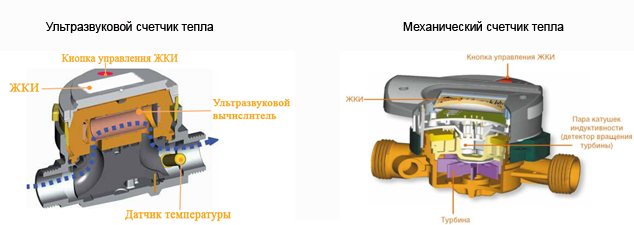
The heat meter data from the water flow sensor is transmitted to the calculator, and also data from two temperature sensors are received to them, which are respectively located in the supply and return pipelines. The calculator processes the initial data and is stored in the archive. All necessary information for the user is transmitted to the screen and can also be read by the data collection system via radio or wired Mbuss.
Report generation:
You have installed an individual heat meter (heat meter) and the question immediately arises of how to read information and generate a report for a heat supply organization. It is necessary to study the operating instructions for the installed heat meter, which describes how to correctly view the necessary information. Depending on the manufacturer of the heat meter, the heat energy is displayed on the display in different physical quantities. This is necessary, 1 Gcal = 4.187 GJ = 1163 kW / h, for the correct transfer of thermal power. The operating organization bills frequently according to the Gcal tariff, so the transfer system must be understood.
Each tenant who has bought a heat meter needs to know that together with the actual readings of an individual heat meter for the apartment, it is necessary to pay for heating in common areas, such as staircases, elevators, basements, on average 0.5 UAH. for 1 m 2 of the apartment's own area.
The methodology for calculating this payment is based on the following legal documents:
Decree from 21 linnya 2005 p. N 630 About the hardening of the Rules for the provision of services from the centralized scorching, constant cold
This hot water and water supply This standard contract for the provision of services from the centralized scorching, supply of cold and hot water and water supply.
Order of October 31, 2006 N 359 About the hardening of the Methodology for the development of a bit of warmth, created by the scorched masses of the living quarters of large apartment buildings, so pay for the scorching
Order of February 22, 2008 N 47 About the hardened Recommendations for storing the Methods of developing the amount of warmth that was created for the scorched masses of the zaholnaya koristuvannya of large apartment buildings, so pay for the scorching.
Sheet No. D11-10 / 37466 dated 10/14/2002. According to the clarifications of the Ukrainian National Social Insurance Agency on civil engineering, 1,2-recommendations for the efficiency for the reduction of heat energy, vitrized on the scorched pretense of the out-of-the-box soundtrack.
Description of the device
The device for commercial metering of heat energy is a monoblock or two-block complex of such devices:
- Microprocessor controller.
- Water flow meter.
- Power Supply.
- Thermal sensors.
Some models of heat meters can only be powered by a rechargeable battery, which reduces their weight and makes them more aesthetically pleasing when used in an apartment, since there are no power wires and there is no need to install an outlet in the immediate vicinity.
Temperature sensors are installed on the supply and return pipelines and connected to the corresponding connectors on the controller body.
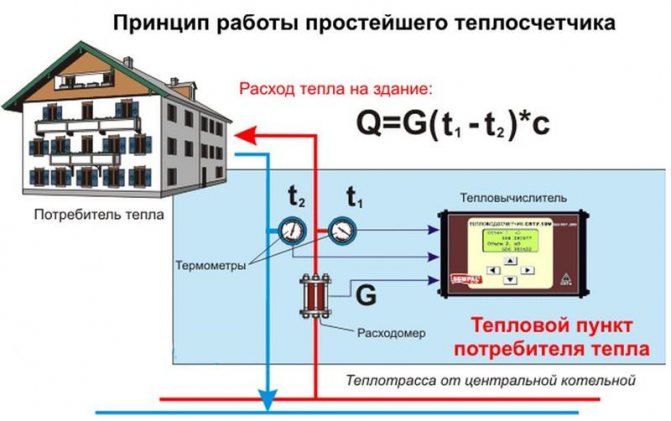

Household heating meter features of the device
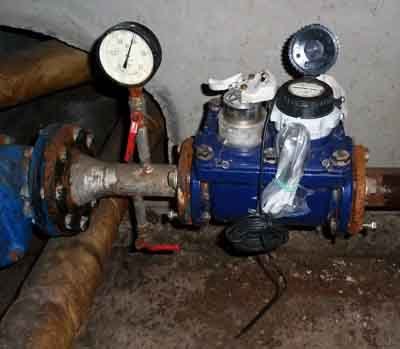

Household heating meter.
Such a device is used in residential buildings. At a meeting of residents, the issue of installing a common house heating meter is being decided - a common device has a number of advantages over an individual meter. Firstly, the common house meter will be much cheaper. Secondly, the readings of the device will be calculated in accordance with the number of residents, that is, you do not need to pay so much. The responsible person, who is elected at the meeting, pays for this utility service. This person is also responsible for the purchase of the meter. A general house meter is much more expensive than an individual type of device, but if divided equally between the residents, it will turn out to be profitable.
The general house meter can be installed by hand. To do this, you need to connect it to the central pipe, which, through the house manifold, provides the house with heating. The second method of installation is installation in the return line. This pipe removes the waste type coolant from the radiator. Both methods of connecting the device are not characterized by the complexity of the work.
The radiator, inside which the heat exchange process is regulated, is at the same time a device for connecting the meter. To avoid problems with its installation, invite a specialist. However, for the services of the master you will have to pay an additional amount. The general house heating meter is installed in the radiator: this will make it easier for you to take readings.
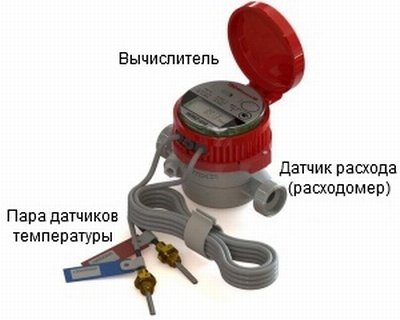

Household heating meter device.
An individual type meter is bought and installed in the apartment by the owner. He pays for everything: the device, the services of the master, receipts. That is, the heat meter belongs to him personally, he is fully responsible for it. An ordinary such device is an ideal solution in case of abandoning a common house meter. The presence of this device greatly simplifies your life: so you will be calm about the honesty of paying for heating. Therefore, it is necessary to install a heat meter, even if the neighbors are against the common system.
There are some difficulties in installing an individual meter. For example, if in your house the wiring is vertical, then the work scheme takes place in several stages, since there is no central part of the heat supply. That is, it is necessary to introduce a riser into all rooms of the apartment.
The problem is solved by attaching the heat meter to the radiator. The radiator regulates the heat transfer process, and the fixed device regulates the amount of heat produced. At the same time, the counter works efficiently and for a long time. The price of a meter for heating to an apartment is much more expensive, since it is considered more reliable and has a warranty from the manufacturer.
Pros and cons of a heat meter in an apartment
If you decide to install an individual heat meter in your apartment, then do not know that there will be no “super” savings, but it will allow you to save on heating within reasonable limits, reflecting the current consumption. Thanks to the counter, it is possible to monitor consumption in the event that the unit is made correctly, and the thermostat controls the temperature regime. If you leave home, you can reduce the degrees and thus, at the end of the month, you can see the positive dynamics of savings.
More information about thermostats for heating radiators can be found here
Only a 1-degree reduction in performance can save up to 6% heat energy.
As already noted, in order to install such a device in your apartment, you need a list of documents:
- permission from the institution on the balance sheet of which the house is located;
- technical requirements from the balance holder of the building supplying thermal energy;
- the calculated design of the heat consumption unit, based on the parameters of the device, the finished calculations also need to be verified with the standard values;
- further installation is carried out, according to the data of the finished project;
- then you need to conclude an agreement to the main contract with heat suppliers. It will record the amount of payment, which is based on the indicators of the individual meter;
- and finally, an act of delivery of the assembly of the unit is drawn up with a representative of the organization that supplies the heat, and the device is registered.
Metering devices and savings
The installation of devices does not yet guarantee a real reduction in service charges. What needs to be done to reduce the amount in bills? Having installed, apartment metering devices, in conjunction with regulating valves, you will receive and pay exactly as much as you need.
With this approach, your dependence on the actions of your neighbors will be less.
Practical scheme for installing heating meters:
- In the place of the branch of the common riser, a metering device is placed. These works should be performed only by professionals and sealed by specialists from the management company.
- Thermostats are installed near heating radiators. With the help of them, the coolant supply is regulated. If there is no money for such a solution, then an ordinary valve can also be installed. Remember that it is not advisable to use screw versions. Because the gasket can close the pipe at an unexpected moment, which will lead to a decrease in the temperature in your apartment.
- Ideally, thermostats should be mechanical or electronic. The essence of their work is simple: they have a temperature sensor, which is located outside the zone of air flows rising from the battery. After proper tuning, they will provide the system capacity that is necessary to maintain the programmed air temperature in the apartment.
What actions can be taken by the owners of premises equipped with a standing heating system? It is very expensive to install equipment regulating the coolant supply on each battery. Such a project is unlikely to recoup the initial investment. Do not forget about the need for regular maintenance of these facilities. The owners can be helped by the installation of electronic thermometers. They are also called heat distributors. It continuously records the temperature of the air and the surface of the battery.
The cost of such a device is low (about 1000 rubles). You need to attach it directly to the radiator. There will be a good incentive to conserve heat, since the payment will be for the actually received resource.
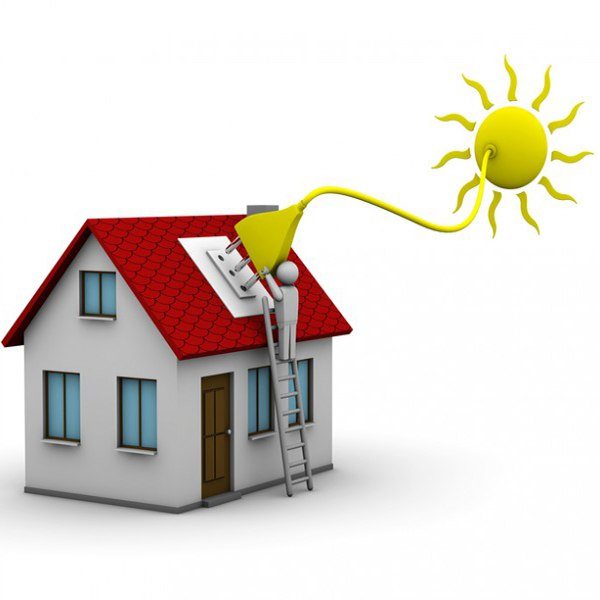

Heating system in an apartment building Heat meters for an apartment building How to change the management company in an apartment building
Shortest path to production: (812)274-4637 or (812)983-4992
HEAT METER - THE PAST CENTURY. CHANGE YOUR HEAT METERS FOR AN INDIVIDUAL METER
HEAT ENERGY CALCULATOR TECHEM radio 4 with radio module
Thermal energy calculator TECHEM radio 4
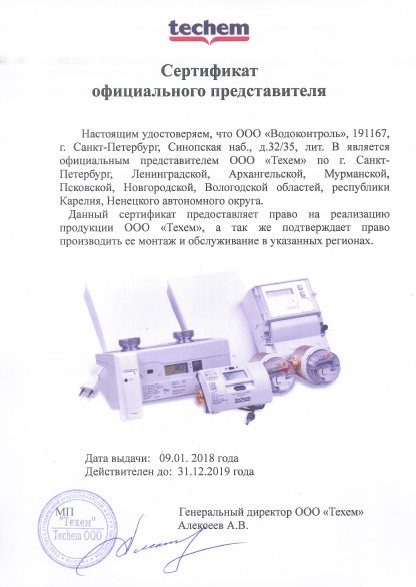

TECHEM Official Partner Certificate
After a long legal battle, the citizens of Russia received the right to install individual heat energy meters from one apartment. Unfortunately, the government of the Russian Federation did not give a damn about the decision of the Constitutional Court of the Russian Federation No. 30-P of July 10, 2018 and carried out its instructions formally. It could not have been clearer to show the people whose interests are really closer to the government. Unfortunately - not consumers of thermal energy, whose interests in other countries are protected to a much greater extent. Unfortunately, the Ministry of Construction is more concerned with the purses of the heat monopolists than with our long-falling incomes. Not to mention the environment, which is also less important than the super profits of heat traders. But the specifics are as follows: the government of the Russian Federation provided citizens with formula 3 (1), according to which the calculation is carried out in cases where the house is equipped with a general-house heat metering device and at least one, but not all premises of the house are equipped with individual metering devices. Its essence is that if one apartment in a house is equipped with individual heat energy devices, then all other apartments (!) Calculate their individual consumption according to the indications of these devices. One zealous owner of an apartment - a heat consumption thermometer for the whole house. Those who wish can familiarize themselves - this novel is introduced by formula 3 (7), which is an integral part of formula 3 (1) - according to formula 3 (7), the individual heat consumption of apartments in which there are no heat meters is calculated. I repeat - the individual consumption of apartments where there are no individual heat metering devices is calculated according to the readings of the devices that are installed in one apartment of the house. Simple and ingenious, it clearly shows how much heat-polishing companies and the government of the Russian Federation do not want citizens to measure their heat consumption. In practice, the use of these formulas leads to the fact that for a citizen who wants to save on heat, individual consumption in the total amount of payment for heat is 15-25%, and the cost of general household needs, respectively, 75-85%. And the payment for heat remains the same as it was. It is not hard to guess that such large expenses for general house heat oblige the citizen to pay for the heat of his neighbors, who live all winter with open windows and do not think about these issues yet. This state of affairs directly contradicts the text of the above-mentioned resolution of the Constitutional Court of the Russian Federation and the judicial challenge of these formulas is proceeding as quickly as possible, about which we will inform you on our website. However, mathematics is an exact science and these formulas have an opposite feature - heating bills begin to decrease as other residents of the house begin to install individual heat meters. And you can feel the savings even when 10% of the apartments are equipped in the house. In the case when the number of equipped apartments exceeds 50%, then it becomes more profitable for apartments that have not installed such devices to install them sooner. Among our clients there is a house where 57% of apartments are equipped with TECHEM computers, on the experience of which we discovered this feature. In addition, if the tenants of the house at the general meeting decide on 100% installation of heat energy calculators in the apartments, then the calculations are carried out already according to formula 3 (4), which is quite fair. I would like to add that heat energy calculators can save 30-60% of the payment for heat energy. And this is not an advertising statement, the data on savings are confirmed by the results of an experiment that was carried out by the State Construction Committee of the Russian Federation back in 1997-2003 - check in the introduction to the MDK 4-07.2004 "Methodology for the distribution of general household heat energy consumption for heating between individual consumers based on the readings of apartment metering devices warmth ".The data of this experiment clearly explain the extremely intolerant position of the government of the Russian Federation, as well as those who motivate officials to accept such "formulas" in relation to citizens being able to count the consumed heat. It also becomes clear who motivates the media to print and circulate articles about the fact that heat is an uncountable thing (although general house heat meters have been standing almost everywhere for a long time, and the heat energy calculator was approved for use in the Russian Federation after many years of metrological examinations) or about self-heating walls and ceilings in houses, and about other "miracles" that allow us to sell goods for as long as possible, the quantity of which we cannot even count. Pay only, and we will calculate for you ourselves. Although, for example, in France, the state pays the citizen half of the cost of heat metering devices - if only he installs them as soon as possible. And we accept such "formulas", although the text of the resolution of the Constitutional Court of the Russian Federation directly indicates a commensurate reduction in heating costs for zealous citizens, and the importance of creating conditions for the installation of devices from just one apartment, since to coordinate the will of numerous apartment owners - difficult, and about the preservation of the environment for the present and future generations. But what about the environment when it comes to hundreds of billions of rubles? By the way, there are billions of us with you. Therefore, at present, the desire of a citizen to pay only for actually consumed heat forces them to unite with other citizens. We are ready to offer significant discounts for collective orders.
DECISIONS OF THE COURTS
The Frunzensky District Court of Vladimir ordered the management company to accept the TECHEM heat energy calculators and carry out calculations for them. Solution HERE
THE DECISION of the Dzerzhinsky District Court of St. Petersburg on the obligation to carry out calculations according to the indications of the TECHEM heat energy calculators HERE
On September 2, 2019, the Moskovsky District Court of St. Petersburg ordered Zhilkomservis No. 1 of the Moskovsky District LLC to take into operation and carry out calculations based on the readings of the TECHEM FHKV heat energy calculators, which are installed in apartment 44, Kosmonavtov Avenue in St. Petersburg. Case No. 2-3468 / 2019. The effective court decision HERE
Krasnogvardeisky District Court of St. Petersburg ordered ZhKS No. 3 Krasnogvardeisky District LLC to take into operation and pay for heating according to the indications of TECHEM FHKV heat energy calculators. The calculators are installed in the usual "Khrushchev" on the street. Bestuzhevskaya. Solution HERE
IT IS POSSIBLE TO SUPPLY INDIVIDUAL HEAT MEASUREMENT DEVICES FROM ONE APARTMENT
In accordance with clause 2 of the decree of the government of the Russian Federation No. 354 of 05/06/2011: "individual metering device" is a measuring instrument (a set of measuring instruments and additional equipment) used to determine volumes (quantity) consumption of a communal resource in one residential or non-residential premises in an apartment building (except for residential premises in a communal apartment), in a residential building (part of a residential building) or home ownership. In accordance with the appendix to the certificate No. 63458 on the approval of the type of measuring instruments - electronic devices for calculating thermal energy TECHEM FHKV radio4 are used in the housing stock with one-pipe or two-pipe vertical and horizontal distribution systems for heating circuits. The device calculates and displays the amount of consumed thermal energy in kilowatt hours.
You can read the certificate HERE, with a description of the type HERE or on the Rosstandart website HERE. Thus, the State Federal Agency for Technical Regulation and Metrology recognizes the TECHEM radio 4 heat energy calculator as an individual heat meter that allows you to measure the amount of heat energy consumed from one apartment or room in houses with any - vertical or horizontal - heating system. Thus, the device we offer, both from a technical and a legal point of view, fully complies with Russian legislation. Moreover, our device has no competitors to date.Therefore, we offer to install our devices for everyone. For those living in St. Petersburg, the price for a turnkey installation of one device per radiator starts from 3,500 rubles, depending on the type of radiator.
Advantages of the TECHEM radio 4 thermal energy calculator:
- much cheaper than a flow-type apartment heat meter
- certified for both horizontal and vertical heating distribution
- readings in kilowatt-hours - it is very easy to convert into rubles - convenient for both residents and the management company
- calibration interval of 12 years - the tenant does not need to spend 4-6 thousand rubles every 4-6 years on checking the heat meter
- no operating costs, when flushing the heating system, devices cannot be damaged - like heat meters
- built-in radio module allows you to collect readings remotely by connecting it to the TECHEM SMART SYSTEM
- the highest measurement accuracy - the error is much less than that of flow-through heat meters
- simple, quick and clean installation
- payback period 1-2 years
Special prices for developers and collective applications.
Want to save even more on heating costs? Also, to save heat energy, you can use Techem "FHKR-IP" electronic programmable thermostats. TECHEM FHKR-IP and HKR intelligent thermostats allow you to set up automatic regulation of the heating agent supply to the radiator and save even more money with the help of intelligent functions of these thermostats, such as automatic lowering the temperature of the radiator when opening the window. You can purchase thermostats and related equipment in our online store or order direct installation in our organization.
For all questions, call 274-4637 or 983-4992 during business hours.
WE INVITE PARTNERS FOR DISTRIBUTION IN THE REGIONS AND IN St. Petersburg. BEST CONDITIONS FOR FIRST PARTNERS. For cooperation, call during business hours (812) 274 4637, 274 6159.
OUR PARTNERS By contacting our partners, you can be sure that your computer will be programmed using original equipment and installed in accordance with technological requirements.
IE Fedotov Nikolay Nikolaevich ("Accounting-Service")
ATTENTION!
For installation and programming of heat calculators, you need:
— Photos and parameters of each heater in the apartment. VT - mounting width. VN - mounting height. EL - the length of the element. G - the number of sections. NA - the distance between the bushings. SZ - the number of heat-bearing racks or radiator fins. BL - the length of the radiator (for steel or panel). — Photo of a heated towel rail. If the heated towel rail is powered by central heating (CH), then the installation of a calculator is required. If the heated towel rail is powered by hot water supply (DHW), then the installation of heat calculators is not required.
The photos below show the main parameters of each type of radiator (click on the picture to enlarge).
To send an application, you need to indicate your contact information and fill out the table (by clicking the + button). Each line of the table is filled in for each radiator for which a calculator is required to be installed.
! Be sure to upload photos of your heaters. ! In the comments, be sure to write the installation location of the device. ! In the message, it is necessary to indicate the postal address (with the index) of the installation of the devices.
After filling in the table, click the "Submit" button
|
|
|
|
|
|
Length of the straight section of the pipeline.
Many types of flow transducers require long straight runs before and after the installation site for correct measurement. This is true for ultrasonic and differential pressure flow meters. But in practice, in the absence of adapted premises, it is not always possible to satisfy this requirement.
Measurement channels.
Modern heat meters are complex metering systems that can service metering simultaneously through two or more heat inputs and through the hot water supply line. In this case, the heat meter becomes universal and can satisfy the requirements of a wide variety of heat consumers.
The presence of a diagnostic system.
Most heat meters are equipped with a self-diagnostic system, which provides periodic automatic check of the device status and provides information about the nature of the failures that have occurred, the time of the beginning of the failures and their duration. At the same time, the devices can register abnormal situations that occur in the heat supply system, such as the current flow value out of the range set for the device or outside the settings entered into the device memory, power outage, unbalance of masses in pipelines, etc.
Energy independence.
Energy independence should be considered from two positions: interruptions of the mains (220 V) power supply and operational safety. Power interruptions can be dealt with by using uninterruptible power supplies, and safety is important when operating heat meters installed in damp and humid rooms (basements), as well as in social facilities: in kindergartens, schools, etc.
Operating conditions.
When choosing heat meters, it is necessary to take into account the quality of the heat carrier. If there is a likelihood of the presence of mechanical and gas impurities in the water, then it is not recommended to use ultrasonic and tachometric heat meters.
In this case, electromagnetic and vortex heat meters are preferable. If the water contains ferromagnetic impurities, it is not recommended to use tachometric heat meters and vortex ones with electromagnetic signal pickup. If there are impurities in the network water that form films or deposits on the inner surface of pipelines, it is not recommended to use electromagnetic heat meters, etc.
Completeness of delivery.
When using single heat meters or composite heat meters obtained from one supplier, the compatibility of blocks and elements and their overall performance are guaranteed. Otherwise, there may be problems associated with the adaptation of the heat meter to specific conditions of use and do not appear at the commissioning stage.
Calibration interval.
Since the calibration interval is an economic category (the cost of periodic calibration is up to 10% of the cost of a heat meter), you should choose heat meters with the largest calibration interval. Currently, it is for different heat meters from 2 to 5 years.
The presence and depth of the archive.
Almost all modern heat meters archive information with the possibility of subsequent retrieval of archived data directly from the device or using additional terminals
In this case, the ability to display archived data on the instrument panel is of great importance.
Cost and reliability.
The cost of a set of various heat meters fluctuates in a wide range and depends on the thermal load of the building, the number of heat measurement channels, the need to measure the pressure in the pipeline, the presence of additional external equipment (printer, modem), supplier (domestic, foreign) and other factors. The cost of a heat meter directly correlates with reliability.
How tenants without meters overpay for heat
Payment for heat in houses where a common house heat meter is not installed is not for the amount of heat that is used, but according to the design (calculated) data.
The design data, as a rule, includes the maximum heat consumption for a particular house.
The actual heat consumption is almost always lower than the design (maximum) consumption.
The only exception is very old and emergency houses with worn out communications, houses with thin walls and without insulation.
Thus, tenants who live in houses without general house meters pay the maximum.
From our practice, the actual heat consumption is approximately 2 - 2.5 times lower than the design one.
To overpay 2 times for heat is a lot.
But that's not all.
In the networks through which heat enters your home, all sorts of losses occur.
Regulatory losses
Some of the heat losses are planned (standard) losses.
The heat that travels through long pipes to your home is somehow cooled down a little.
These are the normative - “normal” heat losses.
Everyone pays for these losses - residents of houses with and without general house meters.
The second part of heat losses is not standard (not planned).
Abnormal losses
Non-standard losses, as a rule, arise through the fault of the heat supply organization.
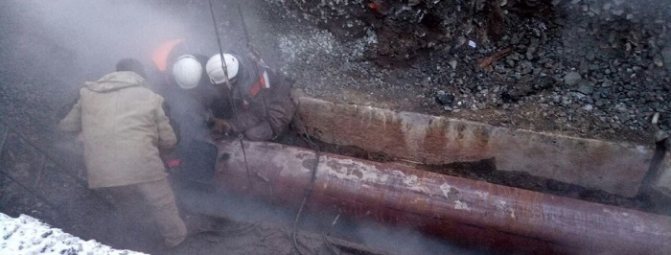

Abnormal losses
Reason for abnormal losses:
- worn out or missing pipe insulation,
- pipe breaks,
- wear,
- outdated equipment,
- crashes,
- lack of network adjustment and
other "shoals" of heat supply organizations.
Heat supply organizations cannot accurately track the causes, place and amount of losses in networks.
Therefore, all non-standard heat losses are passed on to the residents of houses without common house meters.
Another problem that arises in houses without common house heat meters is the quality of the heat carrier.
Residents of houses without common house meters pay for heat of high quality, or they can receive heat of a lower quality.
If, for example, the temperature of the coolant is lower than that stipulated in the contract, it is impossible to prove this without a meter, so you will have to pay for everything in full.
If a common house heat meter is installed in the house, tenants may require recalculation of the payment for heat with a temperature lower than that specified in the contract.
Summarizing.
Residents in houses without general house meters overpay for three reasons:
- Payment for heat is made according to the design (maximum) consumption indicators, which, as a rule, are 2 times higher than the actual ones.
- Payment for abnormal losses that arise in networks, as a rule, is shifted to houses without common house meters.
- Houses without meters are paid for the quality of heat under the contract, but in fact they can receive heat at a lower temperature. This overpayment cannot be reimbursed without a counter.
Installing a heating meter
Any installation work of the heating system (including the installation of a heat meter on a battery) is carried out only by specialists. To start installing the meter for heating, you will need:
- Order a device installation project.
- Coordinate the package with documents for permission to install with utilities.
- If the commission approves, then the project is implemented and heating meters are installed in the apartment.
- The meter should be registered with the public utility (otherwise it is considered invalid), after which it is given for use.
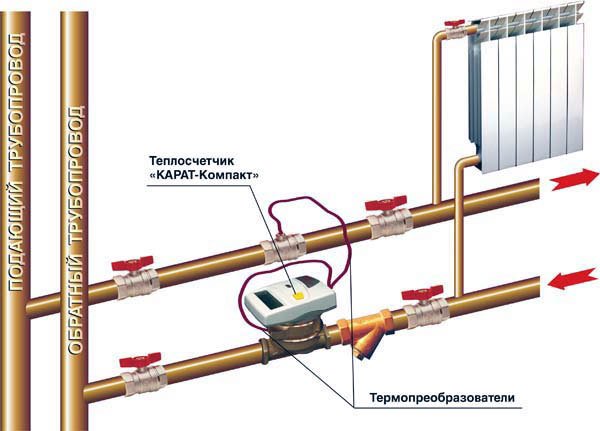

Installation diagram of meters in an apartment in the heating system.
After the listed procedures, you can call specialists. They have to:
- Implement this project.
- Coordinate documentation on heat supply matters.
- Mount the accounting device.
- Officially register your device.
- Hand over the heat meter for use and transfer it to the supervision of a supervisory organization.
Any meter must have a passport and certificate. The documentation indicates the date of the first verification of the device by the manufacturer.
This period is also indicated on the device itself in the form of a stamp. During use of the heat meter, it is necessary to check its operability. The verification of the counters is done depending on the model of the device. It usually takes place every 4 years. After the expiration of the term on the stigma, you should contact either Rostest at your place of residence, or an organization that specializes in checking meters.Manufacturers should also check the devices (as a rule, each company has a service).
How to pay for heating by the meter? To pay for utilities, you should look at the number shown on the device. Next, fill out the receipt, in it you will see the difference between the current and previous readings. Finally, multiply the number on the meter by the current tariff and pay for heat energy.
The principle of operation of the heat meter
This device has 2 sensors, one of which is called a flow sensor, the other is called a temperature. The task of the first is to calculate the amount of consumed heating, the second is to measure the temperature. The main part of any meter is a heat calculator. This is a kind of calculator, it gives the counting results. To do this, multiply the amount of heating consumed by the meter by the temperature. Thus, you get the readings from which you pay later.
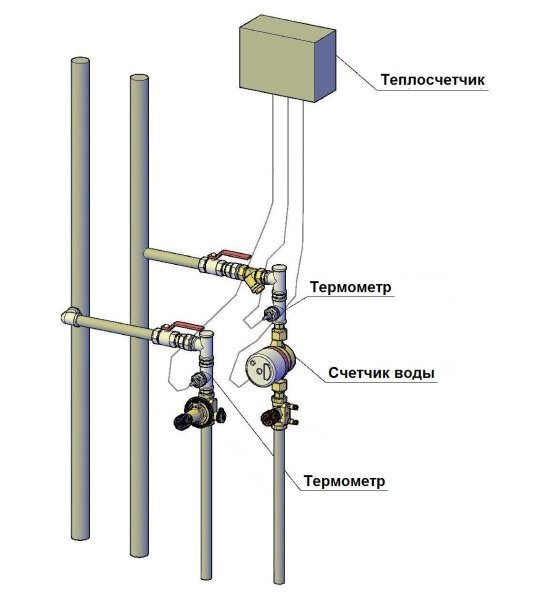

Installation of a heat meter.
Checking counters. Verification must be performed once every 4 years. The purpose of this procedure is to determine the suitability of the instrument. The verifier must make a corresponding note in the device's passport and write you a certificate, which will be a confirmation of the meter's performance.
Benefits of using heat meters
Tariffs are formed on the basis of average consumption indicators, which are often higher than real figures. If you install heat meters for heating for an apartment, then it will be possible to control this expense item and regulate the temperature in the room at any time of the year.
The metering device will allow you to take readings every month and pay only for the volume that was used to heat the dwelling.
We draw the attention of consumers that from 2020 each individual metering device must be verified with the obligatory entry of the result of the verification into the Federal Information Fund for Ensuring the Uniformity of Measurements at ROSSTANDART. Website https://www.fundmetrology.ru/default.aspx
The real benefits of using meters:
- Manual or automated temperature control in the apartment.
- Setting up the heating system for specific needs.
- Simplified diagnostics and maintenance.
When using meters, it makes sense to install thermostats to regulate the temperature. In addition to saving money, they will help create the most comfortable conditions for all family members. This is especially true for spring and autumn, when warm weather lasts for a long time.
Let's make a reservation right away that the most profitable option for using a heat meter is when horizontal piping with one input and one metering device is installed. As a rule, these are modern new buildings.
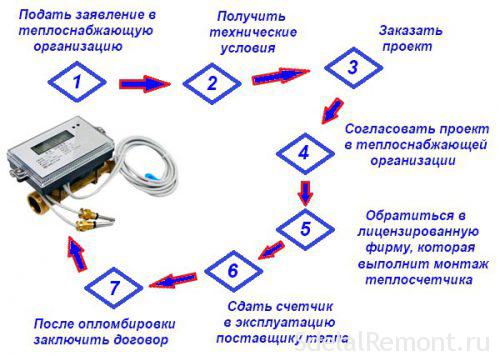

The procedure for installing a heat meter in an apartment
Installation of a heat meter will not bring much savings, but it allows you to control and save within reasonable limits the amount of heat consumed. In simple words: reducing the air temperature in the room by 1 ° C (this can be done using a thermostat on heating devices) allows you to reduce heating costs by 5-6%.
How a heat meter works, types and characteristics of these devices
For this reason, accounting for the consumption of consumed thermal energy is possible only when installing a separate meter for each radiator, which is economically impractical. In this case, it is recommended to install a group metering device either on the house as a whole, or on a separate entrance (although the latter option is used very rarely).
So, where to start work on installing a heat energy meter:
- It is necessary to obtain a document called technical conditions from the local heat supply organization.
The technical conditions usually indicate the place and method of installation, the requirements for the meter (nominal bore diameter, temperature range and other data), in addition, a schematic diagram of the installation with certain regulatory requirements in terms of some dimensions must be attached.Heat meter installation project
- Based on the technical conditions, the homeowner himself has the right to decide which meter to put on heating, but it is not recommended to make a choice on his own. The fact is that the next document to be obtained is a project for installing a metering device for the received heat energy.
The development of project documentation should be carried out by a firm that has the appropriate license. Be prepared for the development of the project will take a significant amount of time, while the cost of this document is commensurate with the price of the purchased meter.
But it is worth paying tribute to the designers, in many cases they advise the metering device that is most suitable for certain conditions, so you should listen to their advice.
The main thing is not to be mistaken in choosing an organization that will develop a project for installing a heat meter, try to give preference to trusted companies with real reviews.
- The developed project is subject to obligatory agreement with the heat supplying organization.
Although serious designers solve all these issues themselves thanks to long-established working relationships, however, this may affect the cost of project development services. - Based on the permits received, you can already choose a specific meter.
Usually there is an opportunity to purchase 2-3 modifications from different manufacturers. - The installation work should be entrusted to certified companies. Self-installation of a heat meter or the services of dubious specialists can turn into problems when putting the meter into operation.
- Upon completion of all installation work, the meter must be accepted by representatives of the supplier of heat resources.
On average, the entire procedure associated with installing a heat energy meter can take 1-6 months, it all depends on the amount of money invested and the promptness of all organizations involved.
Features of installation of a heat meter
Let's figure out how to install a meter for heating.
In order to start the heating season with the installed metering device, it is recommended to start acting in advance. The order is as follows:
- it is necessary to contact the housing and communal service, which issues technical conditions for connecting the meter. All parameters for temperature and pressure of the network will be indicated on one sheet;
- then the device is purchased. It is best to do this in a legal organization so that the meter is certified for quality. The check is saved, the date of verification is checked in the certificate;
- a design organization is selected that has the right to perform these services. A project is drawn up according to the available technical conditions and the purchased device;
- with a ready-made project assignment, you are looking for an organization that will install the devices. She coordinates the time of work with the housing office. It will be better if they are performed at a time when there is no water in the heating system. This will help save not only time but also money;
- installation is done quickly, within two hours. You will first have to prepare a place for welding;
- as soon as the installation work is completed, with all the documents, go to the ZhEK so that they take the meter into operation. At the appointed time, their representative will come to you, seal the device, draw up an act of commissioning, and give one of its copies to your hands. It remains only to conclude a payment agreement, and you can pay for the heat energy consumption using the meter.
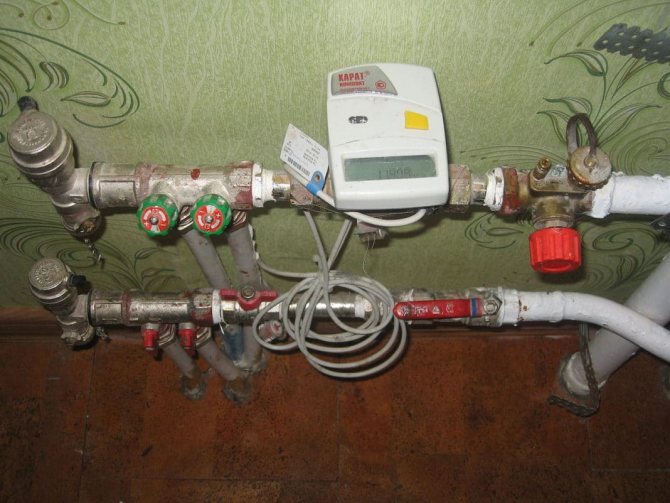

Installed heat meter
The whole process takes from two to three months, so such events should be started well in advance in order to have time for everything before the start of the heating season.
If you don't have free time, you can find an organization that will do all the design and installation work for you. Only such services will cost significantly more.
Main technical characteristics
Performance characteristics
Heat meters provide measurement, indication and registration of coolant and heat energy parameters for 1 ... 8 pipelines, their hourly average, daily average and total values, as well as the operating time and the duration of emergency situations in its operation. The depth of the archive is 45 days.
Heat meters provide registration of the specified information on an external device (printer, PC, etc.) through the RS232, RS485, Centronics interface.
The computer is powered from a 220 V alternating current network.
Metrological characteristics
Heat meters, depending on their configuration with sensors, have the technical characteristics shown in the table:
| Flow sensor type | Nominal bore diameter, Du, mm | Flow measurement range limits, m3 / h | Max. temperature value, ° С | |
| Gnaim | Gnaib | |||
| VORTEX | ||||
| VRTK-2000 (VPR) | 15-350 | 0.016 Gnaib | 4-1600 | 150 |
| VEPS | 25-300 | 0.03 Gnaib | 10-1600 | 150 |
| VEPS-TI | 20-200 | 0.04 Gnaib | 4-630 | 150 |
| DRC-B | 25-100 | 0.04 Gnaib | 10-200 | 150 |
| METRAN-Z00PR | 25-200 | 0.04 Gnaib | 9-700 | 150 |
| UPU | 20-200 | 0.04 Gnaib | 4-630 | 150 |
| DRG-M | 50-150 | 0.025 Gnaib | 160-5000 | 200 |
| ELECTROMAGNETIC | ||||
| PREM | 20-150 | 0.005 ... 0.0067 Gnaib | 12-630 | 150 |
| IPRE-1 (1M) | 32-200 | 0.05 Gnaib | 5,6-900 | 150 |
| IPRE-3 | 32-200 | 0.04 Gnaib | 22,7-900 | 150 |
| MP400 | 10-150 | 0.04 Gnaib | 3,39-763 | 150 |
| IR-45 | 32-200 | 0.04 Gnaib | 22,7-900 | 150 |
| "RISE ER" ERSV | 10-200 | 0.012 Gnaib | 3,39-1357 | 150 |
| TACHOMETRIC | ||||
| PMT | 32,50,100 | 0.1 Gnaib | 1-100 | 150 |
| TSA | 15,20 25-250 | 0.04 Gnaib 0.05 ... 0.08 Gnaib | 3,5 7-1000 | 90 150 |
| VMG | 50-200 | 0.025 Gnaib | 60-500 | 150 |
| OSVI | 25-40 | 0.02 Gnaib | 7-20 | 90 |
| WPD, M-T150QN | 20-300 | 0.03 ... 0.09 Gnaib | 3-1000 | 150 |
| М -Т, WS, WP | 15-200 | 0.02 ... 0.05 Gnaib | 1,5-600 | 120 |
| ET, WP, MT | 15-250 | 0.04 ... 0.05 Gnaib | 3-800 | 90; 120; 130; 150 |
| IMW, M-T, E-T, WS, WP | 15-200 | 0.03 ... 0.06 Gnaib | 3-600 | 90; 120, 130 |
| ETW, MTW | 15-50 | 0.04 ... 0.1 Gnaib | 1,5-30 | 90 |
| ULTRASONIC | ||||
| DRK-S | 50-350 | 0.02 Gnaib | 145-1000 | 150 |
| DRC-3 | 80-4000 | 0.01 ... 0.015 Gnaib | 18…450000 | 150 |
| EEM-Q | 15-50 | 0.04 Gnaib | 1,5-15 | 150 |
| SONOFLO | 25-250 | 0.04 Gnaib | 6-1000 | 150 |
| ULTRAFLOW II | 15-250 | 0.03 Gnaib | 1,5-1000 | 150 |
| UFM001 | 50-1000 | 0.04 Gnaib | 85-34000 | 150 |
| UFM003 | 15-40 | 0.02 ... 0.04 Gnaib | 4,5-30 | 150 |
| UFM005 | 15-1600 | 0.04 Gnaib | 2-36200 | 150 |
| UFM500 | >50 | 0.028 Gnaib | 31,25-100000 | 150 |
| RU2K | 10-1800 | 0.04 Gnaib | 2-110000 | 150 |
| SUR-97 | 25-300 | 0.01 Gnaib | 20-2500 | 150 |
| URZH2K | 15-1800 | 0.04 Gnaib | 0.034 DN2 | 150 |
| UZR-V-M "AKUSTRON" | 50-2000 | 0.03 Gnaib | 72-113400 | 150 |
| UFC002R | 50-2000 | 0.04 Gnaib | 60-100000 | 150 |
| UFC-003R | 20-50 | 0.025 Gnaib | 2,5-25 | 150 |
| UZS-1 | 15-2400 | 0.016 Gnaib | 6,3-150000 | 150 |
| UPR-1 | 15-2400 | 0.016 Gnaib | 6,3-150000 | 150 |
| URSV-010 | 50-1600 | 0.284 DN | 0.028 DN2 | 150 |
| URSV-010M "RISE PC" | 50-4200 | 0.0З Gnaib | 0.03 DN2 | 150 |
| URSV "VZLET MR" | 10-5000 | 0.2 DN / r | 0.03 DN2 | 150 |
Calibration interval of the heat meter - 4 years.
Metrological characteristics
| Parameter name | Standard | Special |
| Limits of the basic relative error of conversion of the flow rate into the frequency of the output signal (frequency output),%, in the range of flow rates: | ||
| for UPU1 | ||
| from minimal to transitional | ±1,5 | ±1,0 |
| from transient to maximum | ±1,0 | ±0,5 |
| for VPS2 and VPS3 | ||
| from minimum to maximum | ±1,0 | ±0,5* |
| The limits of the basic relative error of converting the volume of liquid into the number of pulses with a normalized price (pulse output),%, in the flow rate range: | ||
| for UPU1 | ||
| from minimal to transitional | ±1,5 | ±1,0 |
| from transient to maximum | ±1,0 | ±0,5 |
| for VPS2 and VPS3 | ||
| from minimum to maximum | ±1,0 | ±0,5* |
| Limits of basic reduced error of conversion of flow rate into output signal of direct current for ВПС1,%: | ±1,0 | — |
* - only for versions ВПС2
Additional error arising when the temperature of the measured medium changes for every 10 ° C,%, no more than ± 0.05
Temperature range of the measured medium, ° C ………………………………………………………… 5-150
Working pressure, MPa …………………………………………………………………………………………………………………………………………………………………………………………………………………………………………………………………………………………………………………………………………………………………………………………………………………………………………………………………………….
Hydraulic resistance of converters
- for VPS1 and VPS2 at a flow rate of 0.5 of the maximum, no more than, MPa (kgf / cm2) ……… ..0.01 (0.1)
- for VPS3 at maximum flow rate, no more, MPa (kgf / cm2) ………………………………………………………………………………………………………………………………………………………………………………………………………………………………………………………………… 0.03 (0.3)
Housing heat meter working principle
We also recommend that you consider the benefits of a custom heat control system supplied to your home to keep the cost of these costs down. Optimal solutions to the problem of such savings will be found together when we look at the piping in your home.
Quarterly recording of heat energy is possible only with a horizontal wiring system for heat supply !!! *
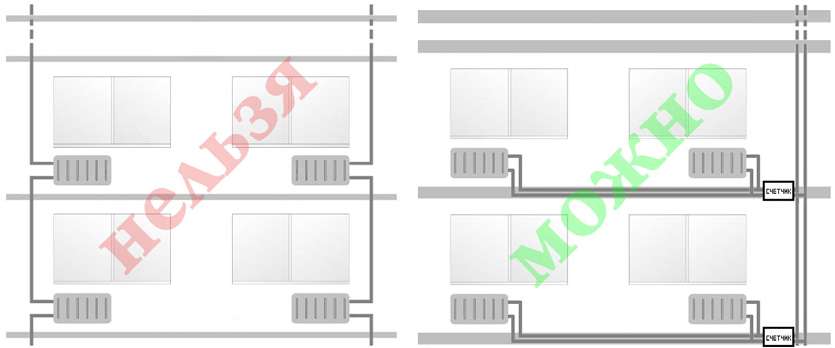

Call us or leave a request on the website, and our manager will contact you.
Our prices
| Installation cost 1 water meter | from 1700 rubles |
| Replacement cost for 1 water meter | from 1400 rubles |
| Meter installation cost | from 12,000 rubles |
| Meter replacement cost | from 7,000 rubles |
| Installing the first radiator | from 3200 rubles |
| Installing the first radiator with 2 1/2 " | from 4200 rubles |
| Jumper | 1800 rubles |
| Installing the first radiator by replacing two 3/4 " | from 4700 rubles |
| Jumper | 2000 rubles |
| Installation of the first radiator by replacing two valves 1 " | from 5000 rubles |
| Jumper | 2400 rubles |
MEASURED MEDIA. AREAS OF USE
Electromagnetic flowmeter - the counter is used in the chemical industry, energy complex, food industry and other industries. It is designed to account for consumption:
- corrosive acids, alkalis and mixtures;
- waste and sewage water;
- non-Newtonian fluids;
- contaminated liquids at metallurgical plants.
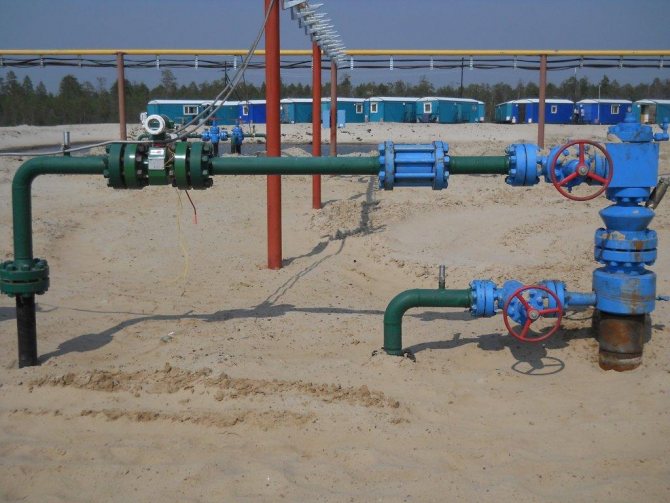

This measuring device is widely used for the needs of public utilities. In particular, it is installed in sewer pipelines. An electromagnetic type wastewater flowmeter works both in pressure and non-pressure pipelines.
Types of thermal heating devices
The main types of heat meters include:
- Tachometric or mechanical;
- Ultrasonic;
- Electromagnetic;
- Vortex.
And there is also a classification by field of application. For example, industrial or customized.
An industrial heat meter for heating is a general house (in apartment buildings) apparatus; it is also installed at production facilities. This unit has a large diameter from 2.5 cm to 30 cm. The range of the amount of heat carrier is from 0.6 to 2.5 m3 per hour.
An individual heating device is the unit that is installed inside the apartment. It differs in that its channels have a small diameter, namely, no more than 2 cm. And also the range of the amount of coolant becomes from 0.6 to 2.5 m3 per hour. This meter is equipped with 2 devices, namely a heat meter and a hot water meter.
Vortex counters
Principle of operation
... In calculating the heat consumption indicators, the phenomenon of the formation of vortices behind an obstacle that has arisen in the path of the fluid flow is used.
Purpose and types
... The frequency of vortex stripping can be removed using ultrasound or a magnetic field and in other ways. The choice of the removal method does not affect the main parameters of the devices, but does affect the operational characteristics.
Features of the
... The reason for the violation of readings can be the presence of large contamination of the coolant, a change in flow parameters, the presence of air. How long the pipeline is does not matter. The main advantage of this device is the ability to install it on the vertical and horizontal parts of the pipeline. The relatively simple design determines the low price. Operating from autonomous sources, such meters consume a small amount of electricity. Since there are no moving parts, there is little wear. But the device is sensitive to vibrations and has a small working range. Installation requires a long straight section of piping.
Service life and calibration of general house heat meters
The service life of a heat meter ranges from 10 to 14 years.
Calibration interval - 4 years.
We recommend that you regularly diagnose, maintain and calibrate the common house heat meter.
Without regular maintenance and verification, the meter will not work correctly, the data may be distorted, as a rule, upwards, and you will overpay for heat.


Energy service contract as a way not to pay for meter installation
A common heat meter can be installed free of charge.
This is how it works.
An energy service company enters into a contract with a HOA or a management company, installs a general house heat meter at its own expense and leases it to the owners of the house.
The owners pay for heat energy according to the meter + 80% of the savings that they managed to get after installing the meter.
Thus, the tenants of the house do not need to look for the amount to install the meter.
The energy service company pays for the installation.
The savings that are obtained after installing the general house meter are divided between the owners of the apartment building and the energy service company.
After the energy service company has returned the initial investment with a small profit, the meter becomes the property of the tenants.
All savings go into the pocket of the homeowners.
Let's take a look at an example.
The cost of paying for heat before installing the general house meter was 500 thousand rubles.
Heat costs after installing the meter are 450 thousand rubles.
Saving 50 thousand rubles per month.


The energy service company takes 80% of the savings to cover the costs of installing the meter - 40 thousand rubles.
Initial investment - 300 thousand rubles
The planned profit of the energy service company is 100 thousand rubles
In total, the energy service company should receive 400 thousand rubles.
Hence:
400 thousand / 40 thousand = 10 months
It takes 10 months to fully recoup the installation of a common house meter.
After the costs of installing the meter are covered (in our example, 10 months), the meter becomes the property of the residents of the apartment building.
The owners begin to receive the full amount of savings that arose from the installation of a common house heat meter (in our example, 40 thousand rubles per month).
Thus, with the help of an energy service contract, you can install a common house heat meter for free, quickly recoup its installation and reduce the cost of paying for heat.
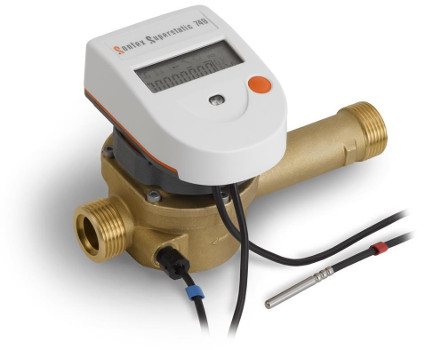

How to install a communal heat meter and reduce heating costs
The meter itself does not save heat.
He only correctly considers your home's heat consumption.
If you have a more or less new house (no older than 15-20 years) - congratulations, immediately after installing a common house heat meter, you will pay less.
If the house is not new, the meter will not only not reduce your costs, but it can also increase your heat energy costs.
Therefore, we recommend:
- Conduct an energy survey of the building and heating system,
- Eliminate all problems and leaks identified during the energy audit.
- Additionally insulate the building.
You need to start with an energy survey.
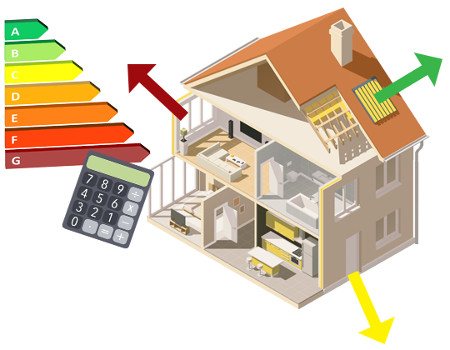

An energy survey will help you identify all problems and leaks, and focus your attention and finances on fixing them.
After the most pressing problems have been eliminated, it is worth insulating your building.
Old buildings, especially those built during the Soviet era, lose a lot of heat.
During the Soviet era, nobody worried about energy efficiency.
There were many cheap resources.
It was possible to heat the street.
Now gas, coal and, as a result, thermal energy are expensive.
Therefore,
- additional insulation,
- high-quality thermal insulation of the roof, walls, attics,
- energy saving windows,
will help you to significantly reduce your heat consumption.
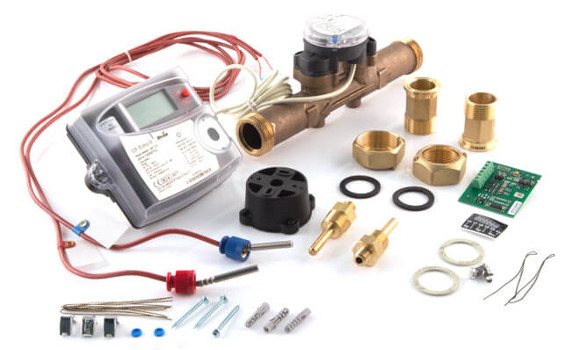

Ultrasonic heat meters
Ultrasonic meters can only be installed in new homes, with new systems and communications.
The principle of operation of an ultrasonic meter is based on the passage of an ultrasonic signal through water.
Water must be free of impurities and foreign particles.
The pipelines must be free of deposits and rust.
In other conditions, the ultrasonic meter will not work correctly, malfunction and overestimate the heat consumption.
Due to the high sensitivity and poor quality of water in our pipelines, ultrasonic heat meters fail more often than others.
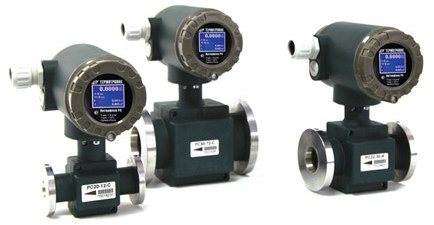

Breakdowns and repairs
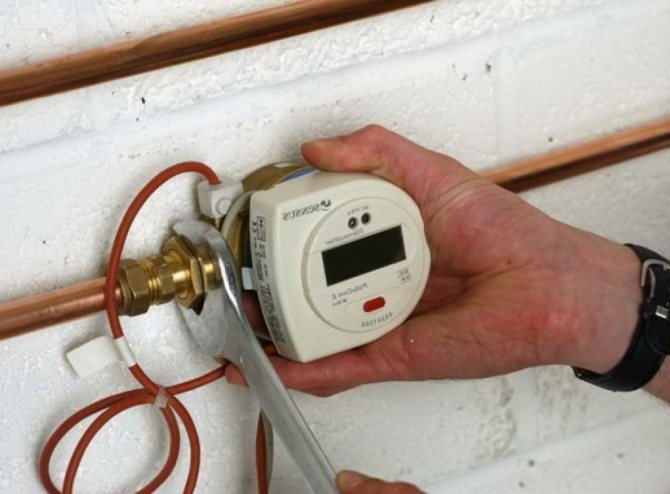

Maintenance of the device is limited to maintaining it in good working order, regular inspection, avoiding causes that cause premature wear and tear. According to clause 80 of the Rules for commercial metering of the coolant, all work on maintenance and control of the correct operation of the meter is carried out by the consumer. On the part of the owner, he does not need special care.
If any malfunction is detected in the metering device, the consumer must notify the service company and the heat supply organization about this within 24 hours. Together with the arrived authorized employee, an act is drawn up, which is then transferred to the heat supply organization with a report on heat consumption for the corresponding period. If the failure is not notified in time, the heat consumption is calculated in a standard way.
The service company will provide services for the repair or replacement of the meter, and during the repair can install a replacement device. The cost of installation and dismantling, repair and other services is regulated by the contract between the consumer and the service company.
Error logging
As a standard, heat meters are equipped with a self-test system that can detect inaccuracies in operation. The calculator periodically requests the sensors, and in case of their malfunction, it fixes the error, assigns a code to it and writes it to the archive. The most common logged errors are:
- Improper installation or damage to temperature sensor or flow meter.
- Insufficient battery charge.
- The presence of air in the flow path.
- No flow if there is a temperature difference for more than 1 hour.
Explore the mechanism of operation and appreciate the benefits of a regulator for a heating radiator by reading this article.
Removal and installation of the heating meter
Before installing a meter for heating in an apartment or an apartment building, specialists from specialized companies that have permits for this type of work are invited. Based on the specific situation, they can make the following commitments:
- Develop a project.
- Submit documents to certain authorities in order to obtain permits.
- Install and register the device. In the absence of registration, payment for the supplied heat is made in accordance with the established tariffs.
- Carry out test tests and put the device into operation.
The developed project should include the following points:
- The type and device of the model, which is designed to work in a specific heating system.
- Necessary calculations for heat load and coolant flow rate.
- Heating system diagram with the place of installation of the heat meter.
- Calculation of possible heat losses.
- Calculation of payment for the supply of heat energy.

